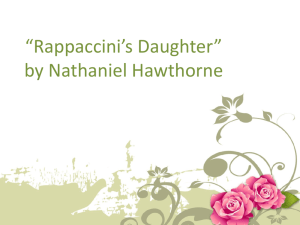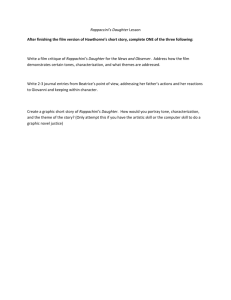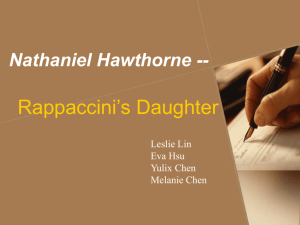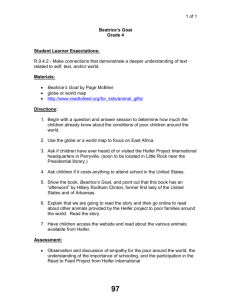Margetich_review 92 - Louisiana Tech University
advertisement
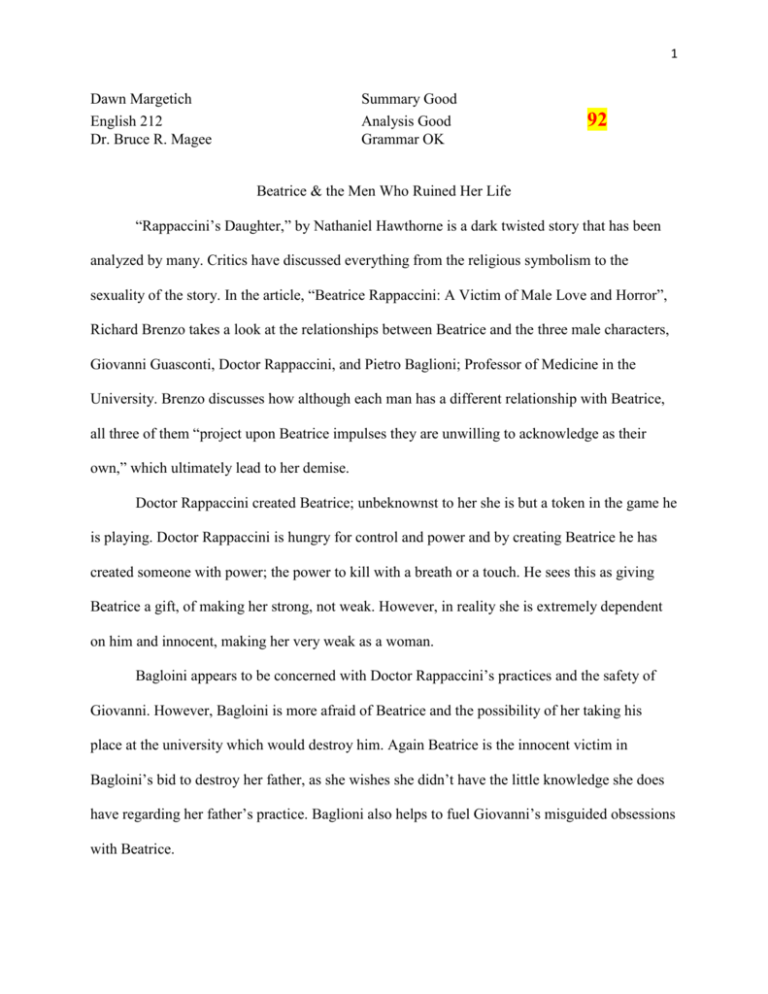
1 Dawn Margetich English 212 Dr. Bruce R. Magee Summary Good Analysis Good Grammar OK 92 Beatrice & the Men Who Ruined Her Life “Rappaccini’s Daughter,” by Nathaniel Hawthorne is a dark twisted story that has been analyzed by many. Critics have discussed everything from the religious symbolism to the sexuality of the story. In the article, “Beatrice Rappaccini: A Victim of Male Love and Horror”, Richard Brenzo takes a look at the relationships between Beatrice and the three male characters, Giovanni Guasconti, Doctor Rappaccini, and Pietro Baglioni; Professor of Medicine in the University. Brenzo discusses how although each man has a different relationship with Beatrice, all three of them “project upon Beatrice impulses they are unwilling to acknowledge as their own,” which ultimately lead to her demise. Doctor Rappaccini created Beatrice; unbeknownst to her she is but a token in the game he is playing. Doctor Rappaccini is hungry for control and power and by creating Beatrice he has created someone with power; the power to kill with a breath or a touch. He sees this as giving Beatrice a gift, of making her strong, not weak. However, in reality she is extremely dependent on him and innocent, making her very weak as a woman. Bagloini appears to be concerned with Doctor Rappaccini’s practices and the safety of Giovanni. However, Bagloini is more afraid of Beatrice and the possibility of her taking his place at the university which would destroy him. Again Beatrice is the innocent victim in Bagloini’s bid to destroy her father, as she wishes she didn’t have the little knowledge she does have regarding her father’s practice. Baglioni also helps to fuel Giovanni’s misguided obsessions with Beatrice. 2 Giovanni Guasconti sees Beatrice in the garden; with the flower that is too deadly for her father to touch; and immediately becomes obsessed with her, not as a woman, but as a possession. Giovanni has a hard time reconciling his imagination of Beatrice and her as she actually is. As he continues to watch and begin a relationship with her he begins to see insects die, flowers wilt; and the unusual relationship Beatrice shares with the flower. He wonders about their relationship, there has been no kissing or touching, not physical contact. With the prodding of Bagloini, Giovanni decides to test Beatrice but realizes because of his relationship with her, he too has become poisonous. Angry; Giovanni goes to Beatrice fueled by all his fear and mistrust he accuses Beatrice of making him just a poisonous as she is. His true feelings about her come to the surface showing he is much more poisonous emotionally than she is physically. Beatrice tries to smooth things over with Giovanni, by taking the antidote first, telling him to wait, and her intentions are honest and innocent. Once again one of the men in her life has had a hand in killing her. I thought the article was interesting. I am always amazed how scholars are able interpret so many different meanings in a story, how they know poison symbolizes death. I was able to see and understand Richard Brenzo’s opinion of Doctor Rappaccini and Professor Baglioni and their relationship with Beatrice, how they “projected” their feelings on to Beatrice. However, his opinions on Giovanni’s relationship with Beatrice were harder for me to understand. It took several readings of the article and the story to see where Beatrice’s sexuality and Giovanni’s “projections” came about. There are so many intricacies in the story, the relationships, the poison, the meaning behind the actions of the characters that I missed during the first read. I enjoyed the story the first time though so it was pleasurable to reread it and look deeper into each 3 character. I think Beatrice truly was a very innocent and isolated girl. I agree that she had no one looking out for her best interest. Brenzo, Richard. “Beatrice Rappaccini: A Victim of Male Love and Horror.” American Literature, Vol. 48, No. 2, (May 1976), pp. 152-164. JSTOR. Web. 17 December 2010.
